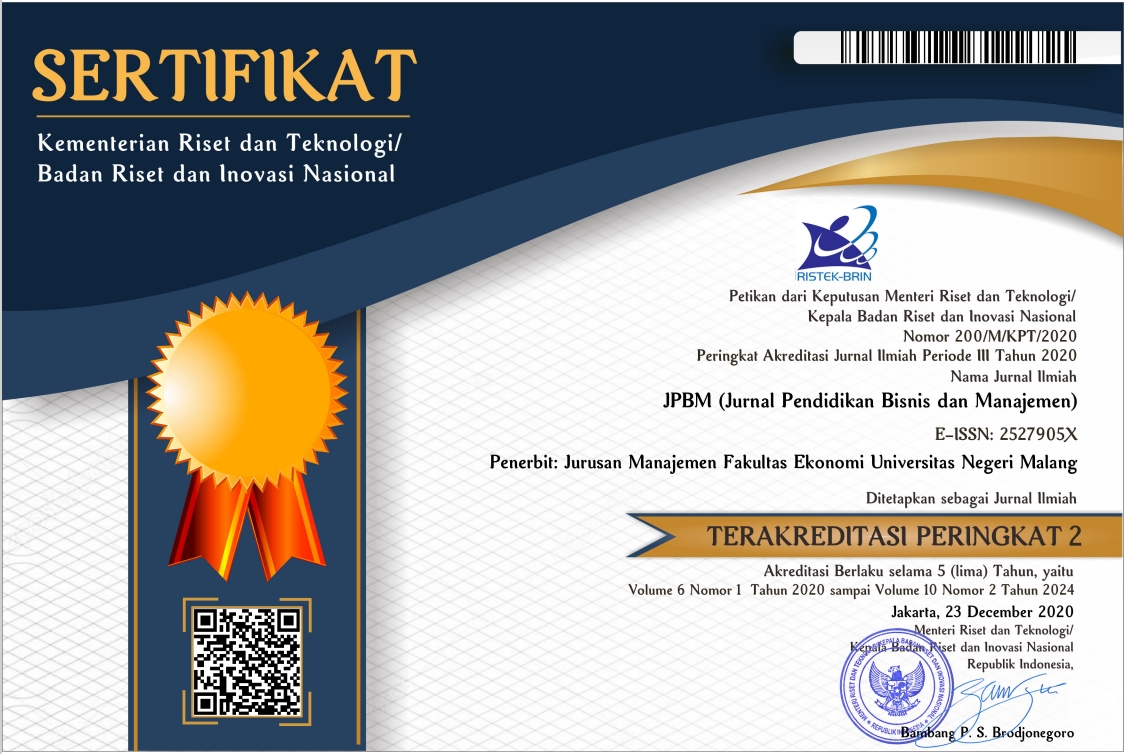Relieving Anxiety in Facing the Workplace for Students: The Role of Self-efficacy, Adversity Quotient, Socioeconomic Status and Perceived Social Support
Abstract
Preparing students’ in entering the workforce is a challenge and understanding the determinant factors affecting students anxiety will useful in understanding phenomenon. This study aims to examine internal and external factors affecting students anxiety in facing the world of work. In detail, the research involved self efficacy, adversity quotient, socioeconomic status and perceived social support to explain students’ anxiety. Using both online and offline questionnaires, approximately 654 participant were involved with simple random technique sampling. Accordingly, the completed data were analyzed using Structural Equation Modelling with SmartPLS. The findings indicate that internal factors (self-efficacy, and adversity quotient, and external factors (socioeconomic status and perceived social support) have a significant influence on anxiety facing the world of work among advanced students in Indonesia.
Keywords: self-efficacy, adversity quotient, socioeconomic status, perceived social support, relieving anxiety.
Full Text:
PDFReferences
Aryani, K. D., Wicaksono, B., & Satwika, P. A. (2017). Hubungan antara kecerdasan adversitas dan efikasi diri dengan kematangan karir pada mahasiswa tingkat akhir di Universitas Sebelas Maret. Wacana, 9(2).
Aryono, S. Y., & Karyanta, N. A. (2017). Hubungan antara adversity quotient dan kematangan emosi dengan toleransi terhadap stres pada mahasiswa pecinta alam Universitas Sebelas Maret. Wacana, 9(2), 1-10.
Astrawan, I. W. G., Nuridja, I. M., & Dunia, I. K. (2014). Analisis sosial-ekonomi penambang galian c di Desa Sebudi Kecamatan Selat Kabupaten Karangasem Tahun 2013. Jurnal Pendidikan Ekonomi Undiksha, 4(1).
Ates, A. (2019). The impact of the emotional intelligence of learners of Turkish as a foreign language on reading comprehension skills and reading anxiety. Universal Journal of Educational Research, 7(2), 571-579.
Axelsson, L., & Ejlertsson, G. (2002). Self‐reported health, self‐esteem and social support among young unemployed people: a population‐based study. International Journal of Social Welfare, 11(2), 111-119.
Bandura, A. (2011). A social cognitive perspective on positive psychology. Revista de Psicología Social, 26(1), 7-20.
Beiter, R., Nash, R., McCrady, M., Rhoades, D., Linscomb, M., Clarahan, M., & Sammut, S. (2015). The prevalence and correlates of depression, anxiety, and stress in a sample of college students. Journal of affective disorders, 173, 90-96.
Bilgin, O., & Taş, İ. (2018). Effects of perceived social support and psychological resilience on social media addiction among university students.
Britton, G. I., Neale, S. E., & Davey, G. C. (2019). The effect of worrying on intolerance of uncertainty and positive and negative beliefs about worry. Journal of behavior therapy and experimental psychiatry, 62, 65-71.
Cheung, C. K., Cheung, H. Y., & Wu, J. (2014). Career unreadiness in relation to anxiety and authoritarian parenting among undergraduates. International Journal of Adolescence and Youth, 19(3), 336-349
Dharmmesta, B. S., & Handoko, T. H. (2012). Manajemen pemasaran analisis perilaku konsumen, edisi pertama. Penerbit: BPFE, Yogyakarta.
Eagle, D. E., Hybels, C. F., & Proeschold-Bell, R. J. (2019). Perceived social support, received social support, and depression among clergy. Journal of Social and Personal Relationships, 36(7), 2055-2073.
Eden, A. L., Johnson, B. K., Reinecke, L., & Grady, S. M. (2020). Media for coping during COVID-19 social distancing: stress, anxiety, and psychological well-being. Frontiers in psychology, 11, 3388.
Etindele-Sosso, F. A. (2020). Insomnia, excessive daytime sleepiness, anxiety, depression and socioeconomic status among customer service employees in Canada. Sleep Science, 13(1), 54.
Fawzy, M., & Hamed, S. A. (2017). Prevalence of psychological stress, depression and anxiety among medical students in Egypt. Psychiatry research, 255, 186-194.
Fenn, K., & Byrne, M. (2013). The key principles of cognitive behavioural therapy. InnovAiT, 6(9), 579-585.
Hair Jr, J. F., Howard, M. C., & Nitzl, C. (2020). Assessing measurement model quality in PLS-SEM using confirmatory composite analysis. Journal of Business Research, 109, 101-110.
Hartini, H. (2016). Pengaruh status sosial ekonomi orang tua dan motivasi belajar siswa terhadap prestasi belajar pada mata pelajaran produktif Akuntansi di Sekolah Menengah Kejuruan Negeri I Kota Jambi. Jurnal Pendidikan dan Keguruan, 1(1), 209672.
Hurlock, E. B. (2012). Perkembangan anak, terjemahan dalam Bahasa Indonesia. Jakarta: Erlangga.
Indrawati, E. S., & Upadianti, L. P. S. (2018). Hubungan antara adversity intelligence dengan kecemasan menghadapi dunia kerja. Jurnal Empati, 7(3), 111–120.
Karyaningsih, R. P. D., Wibowo, A., Saptono, A., & Narmaditya, B. S. (2020). Does entrepreneurial knowledge influence vocational students’ intention? Lessons from Indonesia. Entrepreneurial Business and Economics Review, 8(4), 138-155.
Kumalasari, F., & Ahyani, L. N. (2012). Hubungan antara dukungan sosial dengan penyesuaian diri remaja di panti asuhan. Jurnal Psikologi: PITUTUR, 1(1), 19-28.
Lent, R. W., Brown, S. D., Schmidt, J., Brenner, B., Lyons, H., & Treistman, D. (2003). Relation of contextual supports and barriers to choice behavior in engineering majors: Test of alternative social cognitive models. Journal of counseling psychology, 50(4), 458.
Marni, A., & Yuniawati, R. (2015). Hubungan antara dukungan sosial dengan penerimaan diri pada lansia Di Panti Wredha Budhi Dharma Yogyakarta. Jurnal Emphaty, (3), 1.
Meoli, A., Fini, R., Sobrero, M., & Wiklund, J. (2020). How entrepreneurial intentions influence entrepreneurial career choices: The moderating influence of social context. Journal of Business Venturing, 35(3), 105982.
Nugroho, T.F.A. (2010). Hubungan antara kepercayaan diri dengan kecemasan dalam menghadapi dunia kerja pada mahasiswa semester akhir di Fakultas Psikologi Universitas Sanata Dharma Yogyakarta. Skripsi Psikologi. Yogyakarta
Onyishi, I. E., & Ogbodo, E. (2012). The contributions of self-efficacy and perceived organisational support when taking charge at work. SA Journal of Industrial Psychology, 38(1), 1-11.
Osborn, T. L., Venturo-Conerly, K. E., Wasil, A. R., Schleider, J. L., & Weisz, J. R. (2020). Depression and anxiety symptoms, social support, and demographic factors among Kenyan high school students. Journal of Child and Family Studies, 29(5), 1432-1443.
Phan, H. P. (2011). Interrelations between self‐efficacy and learning approaches: A developmental approach. Educational Psychology, 31(2), 225-246.
Racine, N., Plamondon, A., Hentges, R., Tough, S., & Madigan, S. (2019). Dynamic and bidirectional associations between maternal stress, anxiety, and social support: The critical role of partner and family support. Journal of affective disorders, 252, 19-24.
Rahmawati, N. R., Handarini, D. M., & Triyono, T. (2017). Relation of emotional intelligence, self-esteem, self-efficacy, and psychological well-being students of State Senior High School. Jurnal Pendidikan Humaniora, 5(1), 40-46.
Rodriguez-Hernandez, C. F., Cascallar, E., & Kyndt, E. (2020). Socio-economic status and academic performance in higher education: A systematic review. Educational Research Review, 29, 100305.
Saber, D. A., Anglade, D., & Schirle, L. M. (2016). A study examining senior nursing students' expectations of work and the workforce. Journal of nursing management, 24(2), 183-191.
Saeid, N., & Eslaminejad, T. (2017). Relationship between student's self-directed-learning readiness and academic self-efficacy and achievement motivation in students. International Education Studies, 10(1), 225-232.
Sari, N. P. R. D., & Dewi, D. K. (2013). perbedaan tingkat kecemasan masa depan karir anak ditinjau dari selfconcept dan persepsi dukungan sosial pada ibu anak tunarungu di SMALB-B Karya Mulia Surabaya. Character: Jurnal Penelitian Psikologi, 2(1), 1-7.
Sener, N., Türk, C., & Tas, E. (2015). Improving science attitude and creative thinking through science education project: A design, implementation and assessment. Journal of Education and Training Studies, 3(4), 57-67.
Shkoler, O., Rabenu, E., & Tziner, A. (2017). The dimensionality of workaholism and its relations with internal and external factors. Revista de Psicología del Trabajo y de las Organizaciones, 33(3), 193-203.
Stoltz, PG. (2000). Adversity quotient: mengubah hambatan menjadi peluang (Terjemahan: T. Hermaya). Jakarta: Grasindo.
Suryadi, B., & Santoso, T. I. (2017). Self-efficacy, adversity quotient, and students' achievement in Mathematics. International Education Studies, 10(10), 12-19.
Utami, S., Nashori, F., & Rachmawati, M. A. (2014). Pengaruh pelatihan adversity quotient untuk meningkatkan motivasi belajar siswa sekolah menengah pertama. JIP (Jurnal Intervensi Psikologi), 6(1), 131-149.
Vameghi, R., Akbari, S. A. A., Majd, H. A., Sajedi, F., & Sajjadi, H. (2018). The comparison of socioeconomic status, perceived social support and mental status in women of reproductive age experiencing and not experiencing domestic violence in Iran. Journal of injury and violence research, 10(1), 35.
Waqiati, H. A., Hardjajani, T., & Nugroho, A. A. (2012). Hubungan antara dukungan sosial dan efikasi diri dengan kecemasan menghadapi dunia kerja pada penyandang tuna daksa. Jurnal CandraJiwa, 1(1) , 45-56.
Zhao, S. H., Shi, Y., Sun, Z. N., Xie, F. Z., Wang, J. H., Zhang, S. E., ... & Fan, L. H. (2018). Impact of workplace violence against nurses’ thriving at work, job satisfaction and turnover intention: A cross‐sectional study. Journal of clinical nursing, 27(13-14), 2620-2632.
Refbacks
- There are currently no refbacks.
JPBM (Jurnal Pendidikan dan Bisnis Manajemen) is licensed under a Creative Commons Attribution-NonCommercial-ShareAlike 4.0 International License.
JPBM (Jurnal Pendidikan dan Bisnis Manajemen) is abstracted and indexed in :
















